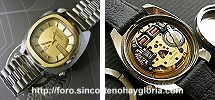|
March 1972 Popular Electronics
 Table of Contents
Table of Contents
Wax nostalgic about and learn from the history of early electronics. See articles
from
Popular Electronics,
published October 1954 - April 1985. All copyrights are hereby acknowledged.
|
 This
Bulova Accuquartz wristwatch is not the first quartz-controlled wearable timepiece;
however, it was the first to be manufactured in the U.S. Interestingly, it is not
a fully electronic watch because the quartz crystal stimulates a mechanical tuning
fork which ultimately drives the hands. Bulova's first tuning-fork-driven "Accutron"
was introduced in 1960. It sported a 360 Hz tuning fork that was stimulated
by a pair of electromagnets. The story appeared in a 1972 issue of Popular Electronics
magazine. The retail price at the time (pun intended) was $395, which in 2023 money
is equivalent to $2,832 (per the
BLS Inflation Calculator)! I found a couple nice photos of the Accuquartz on
the foro.sincortenohaygloria.com website if you want some close-up
views. This
Bulova Accuquartz wristwatch is not the first quartz-controlled wearable timepiece;
however, it was the first to be manufactured in the U.S. Interestingly, it is not
a fully electronic watch because the quartz crystal stimulates a mechanical tuning
fork which ultimately drives the hands. Bulova's first tuning-fork-driven "Accutron"
was introduced in 1960. It sported a 360 Hz tuning fork that was stimulated
by a pair of electromagnets. The story appeared in a 1972 issue of Popular Electronics
magazine. The retail price at the time (pun intended) was $395, which in 2023 money
is equivalent to $2,832 (per the
BLS Inflation Calculator)! I found a couple nice photos of the Accuquartz on
the foro.sincortenohaygloria.com website if you want some close-up
views.
First American Made Quartz Watch

Watch at right is Bulova's Accuquartz while one at left is earlier,
bulky Swiss-made model selling for $1000.
An advanced quartz crystal wristwatch has been introduced by Bulova into a limited
number of Manhattan jewelers at a retail price of $395. This is the first such watch
to be miniaturized to traditional wristwatch size and the first to be completely
manufactured in the U.S.
The crystal is a subminiature sealed type that oscillates at 32,768 Hz, which
is two to four times as great as the crystal frequency in other quartz watches now
on the market. The actual frequency of the crystal is divided down by IC circuitry
to 341 1/3 Hz to drive a tuning fork. The fork, in turn, drives the hands of the
watch as well as the day and date indicators.
The IC used is a single plastic-encapsulated low-threshold CMOS (Complementary
Metal Oxide Semiconductor) manufactured to Bulova specs by Intersil, of Cupertino,
California.
Energy to power the watch is provided by an aspirin-size power cell, which lasts
for about 1 year and must be changed by a jeweler. As for accuracy, the watch can
be expected to gain or lose no more than 1 to 2 seconds per week when worn on the
wrist.
Bulova Accuquartz is a line of watches manufactured by the Bulova Corporation.
It was first introduced in the 1970s and is known for its high-precision quartz
movements. The Accuquartz line represents a significant milestone in the history
of timekeeping, as it marked the transition from mechanical to electronic timekeeping
technology.
Unlike traditional mechanical watches that rely on a complex system of gears
and springs to keep time, Accuquartz watches use a quartz crystal oscillator to
keep time. The quartz crystal oscillator vibrates at a highly accurate and stable
frequency, which is then used to control the timing of the watch. This results in
a level of accuracy that was previously impossible with mechanical watches.
Accuquartz watches are also known for their durability and reliability. Quartz
movements are much simpler than mechanical movements and are therefore less likely
to break or require maintenance. Additionally, Accuquartz watches typically use
long-lasting batteries, which means they can run for several years without the need
for a battery change.
In addition to its high-precision timekeeping and reliability, Accuquartz watches
are also known for their sleek and modern designs. They are often sold at a range
of price points, making them accessible to a wide variety of consumers.
Posted February 8, 2023
(updated from original
post on 10/16/2017)
|











